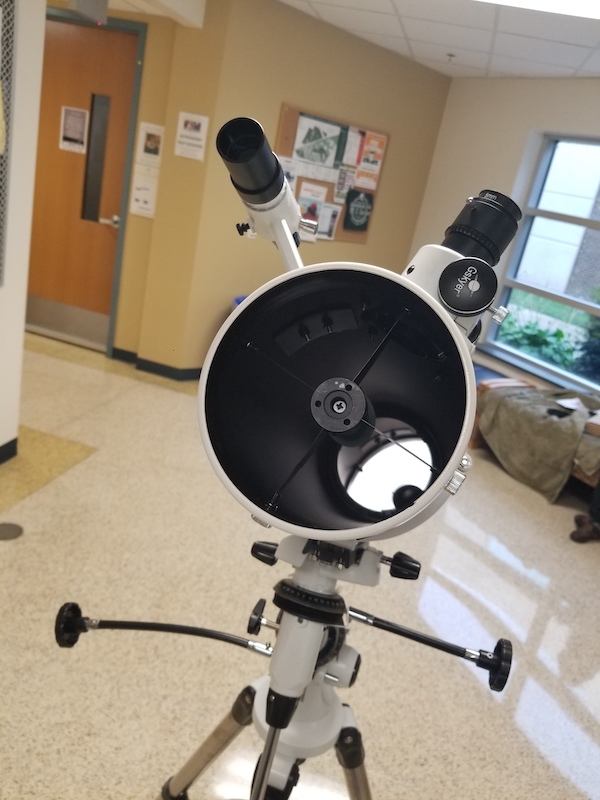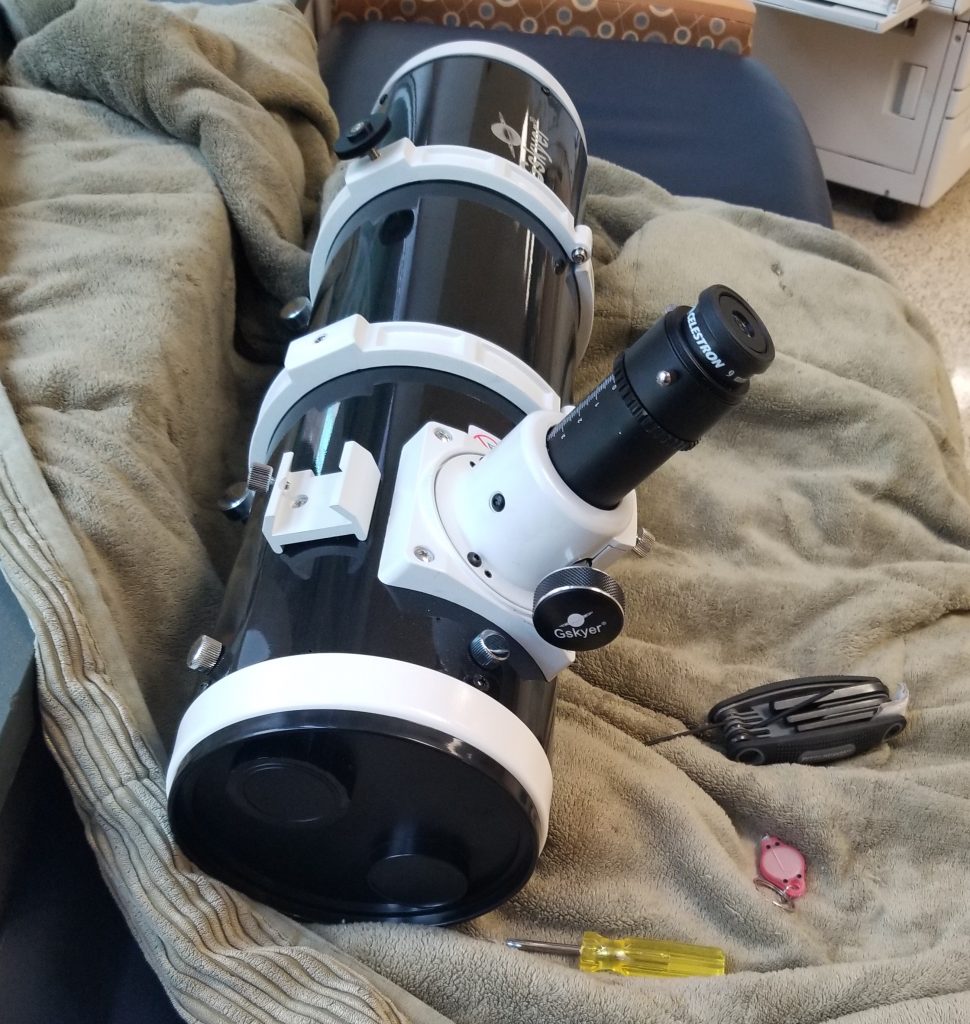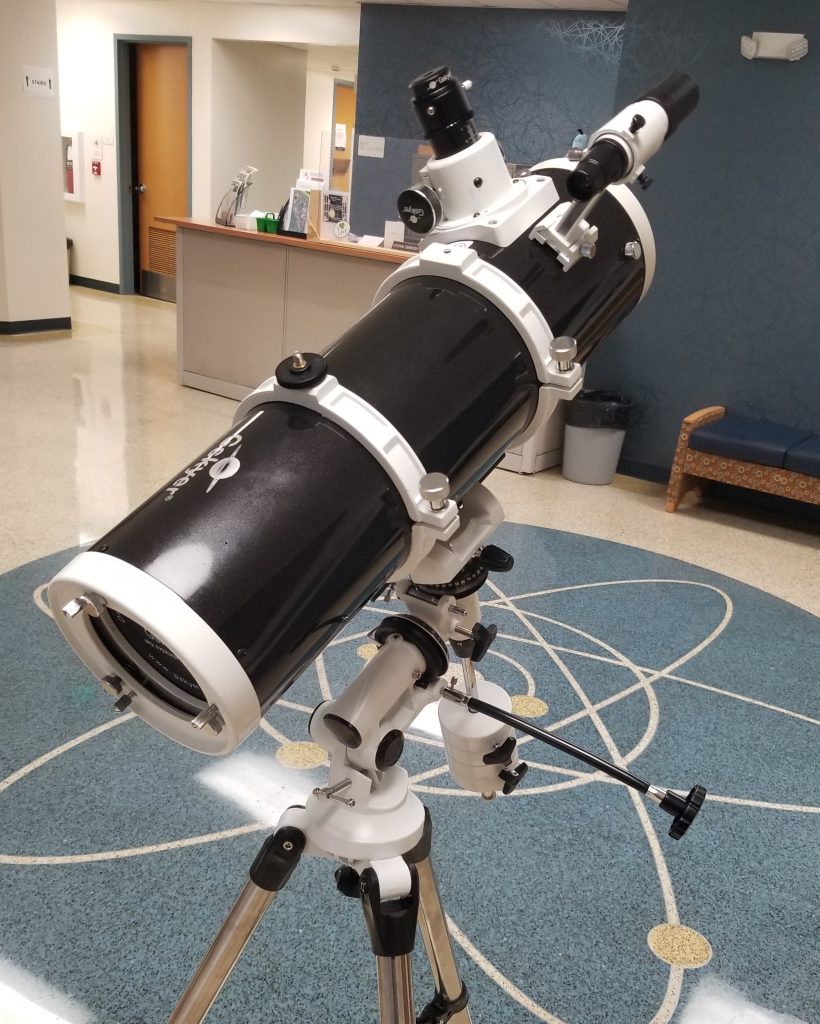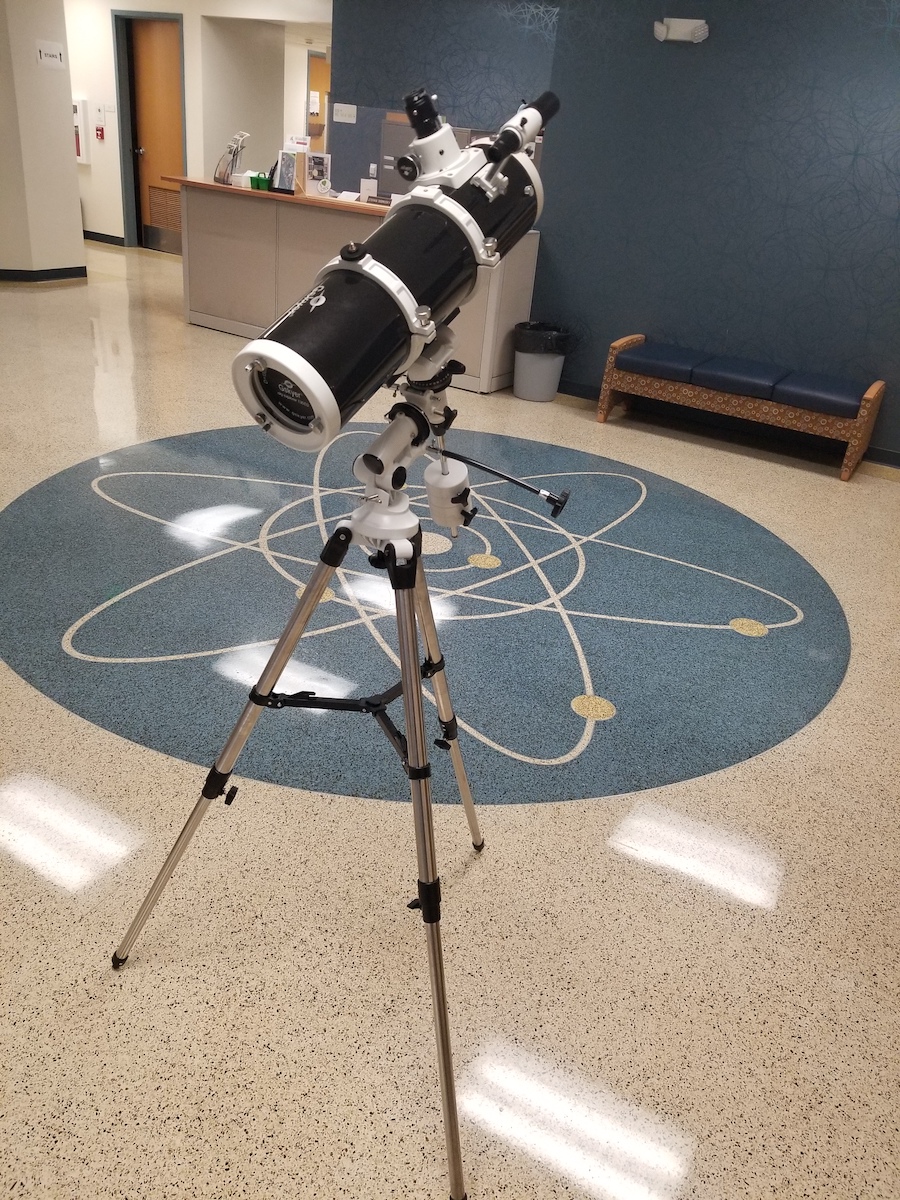A Note about Quality Control
My friend’s telescope came from a reseller on the Facebook Marketplace. We think that these resellers take quality-control rejects from Gskyer and sell them at a reduced price. These might be returns or they might be rejected by the manufacturer, but either way, there’s no mention of what QC problems you might face if you go this route. I cannot verify what the level of quality control is if you buy directly from Gskyer through Amazon, but I will be giving the benefit of the doubt, and after discussing the QC issues, I will pretend they are absent for the rest of the review.
The Gskyer 130EQ I was able to use came out of the box with a gross miscollimation issue—the secondary mirror was not adequately pointed towards the primary, so images were too dim and even fuzzier than the telescope’s optics would suggest. The cause was that one of the vanes holding up the secondary mirror had been badly bent, with about a 30-degree kink in it. This was easy enough to fix manually, but it required secondary mirror collimation.
One of the two focuser knobs turned freely. This was easy to fix—the knob had just not been screwed tight enough. By twisting the two knobs against one another, the loose one was tightened up, and each knob now moved as one.
The chrome metal barrel on most of the eyepieces was somewhat loose. I’ve actually seen more than one Gskyer telescope with eyepieces like this. You’re not supposed to be able to unscrew that barrel; it is a part of the eyepiece, and if you unscrew it while it’s attached to the telescope, you could lose the barrel inside the focuser tube and not be able to slide in another eyepiece. It’s easy enough to tighten that barrel, but I almost wonder if it’s loose on purpose—one of the accessories threads on instead of the barrel (for some reason), so they may just be making sure that’s easy to do. I tightened each of the eyepiece barrels when I took them out.
Finally, the rubber o-ring used in mounting the Finderscope in its bracket was missing. We searched all the boxes and bags but couldn’t find it. That o-ring can be replaced, but we just took some tape and taped over the finderscope where the o ring would have gone, so it fit nice and snug. On the first night, before the tape fix, it was unusable, so I had to replace it with a similar finderscope from a telescope I’d brought along.
The spherical mirror, however, is not a QC issue—it’s a design issue.
The Optics

The Gskyer 130EQ is a 5” f/5 reflector (130mm aperture, 650mm focal length) with a spherical mirror. This is a huge problem right out of the gate because it means the telescope will never be able to show sharp images. The correct shape for a Newtonian telescope’s primary mirror is a section of a paraboloid, which must be figured to a degree of precision better than 1/1000th the width of saran wrap. At a sufficiently long focal length, a spherical mirror would be fine, but short focal-length mirrors like this are so deeply curved that there’s a severe difference between a parabolic curve and a spherical curve. The result is an optical defect called spherical aberration, where a star image can never focus down to a nice, neat dot but rather smears through a range of equally bad blurry disks as you move the focuser through focus. Since all images are made of a bunch of integrated point sources, the result is that not only are stars fuzzier than they should be, but planets are blurry and indistinct, and the Moon is only worth seeing at low power.
As a result of spherical aberration, the highest useful magnification for this telescope is about 100x, with the images looking noticeably fuzzy at magnifications higher than 65x. Further magnification will just make the images dimmer and fuzzier. (For comparison, the useful maximum magnification of a parabolic 5” reflector is about 260x)
It’s not completely unusable—five inches is enough light to see all of the Messier objects from a suitably dark sky, and it’s enough to see most of the showpiece objects bright enough to be impressive. Deep-sky objects tend to be best seen at low magnification.
In addition, the Moon is such a large object that it can reward views at even low magnifications, so while you won’t be hunting for small craters, rilles, and valleys, the Moon will still look pretty good with a lower power eyepiece.
The Optical Tube Assembly
The Gskyer 130EQ has a superficially very nice optical tube assembly. If it weren’t for the substandard optics, it’d be a fantastic telescope tube. It has a collimatable primary mirror cell with collimation thumbscrews, which is better than you get on some telescopes in this price range.

It also has a genuinely nice focuser. The focuser racks in and out smoothly, without any side-to-side play to mess up collimation. It even has gradations on the focuser to keep track of its position, though I’m not sure that’s a functionality that would come up that often. The focuser is 1.25” only, even though the OTA could probably support a 2” eyepiece’s wide field of view. Still, the 1.25” diameter format is still enough for some wide field views at the f/5 focal ratio when paired with a 32mm Plossl eyepiece.
There is also a Synta finderscope dovetail shoe, and the entire telescope sits inside of some tube rings with a Vixen-style mounting dovetail.
The OTA also just looks nice. It’s got the same black diamond style paintjob as a Skywatcher newtonian, with a glittery black tube and white accents. The OTA is outwardly very similar to the SkyWatcher 130PDS, an astrophotography/visual telescope manufactured by Synta (just like the Gskyer 130EQ). Do not confuse the two, though—in addition to the Skywatcher’s 2-inch focuser, it also has a parabolic mirror.
The Equatorial Mount
The mount is identical to the Celestron Astromaster CG3 style mount, an EQ2-class equatorial mount sold with the Astromaster 130EQ (which is highly comparable to the Gskyer 130EQ) and the Astromaster 90EQ (a refractor). The only difference is the paint job and the shape of the counterweights.

The CG3-style mount, unlike the EQ1/CG2 mount, is a decent mount. It’s sturdy and doesn’t have too much play in it. Unfortunately, it is only ever used with telescopes that are too heavy for it. It’s basically the mount that should be used in place of the EQ1/CG2 on all telescopes that use that mount, and all the beginner telescopes sold with it need to be on heavier mounts.
With the 5” optical tube mounted to it, the equatorial mount is shaky, and there is some play in the Right Ascension axis, meaning it’s not moving rigidly and acts a little annoyingly bouncy. In addition, it’s difficult to get the friction and stiction right with the clutches, so moving it constantly involves this difficult problem of pointing it in the roughly right direction, locking the clutches down tight, and using the slow motion cables to center the object. And god help you if the telescope becomes unbalanced while you’re changing out an eyepiece or something, or if you nudge it a bit.
Equatorial mounts are just difficult to use in general. They require a specific setup procedure where you level the tripod as best as you can, point the mount head towards the north star, and set the mount head’s latitude adjustment to your latitude. Once you have the mount at least roughly aligned, the telescope must be balanced. The counterweights have to move on the counterweight shaft until the right ascension axis is in balance, and then the telescope has to move forward and backward in its tube rings until the declination axis is in balance. It is basically impossible to balance the scope evenly if the OTA has an asymmetric mass, such as the all-metal focuser or the finderscope, so when moving the telescope around the sky you may have to change the balance again.
In addition to balancing woes, there’s a problem specific to equatorial mounted Newtonians: the eyepiece can end up in all kinds of weird positions. When you move from one part of the sky to another, the eyepiece might suddenly be pointing down toward the ground or straight up while the tube is too high to look through, or the eyepiece might be in the right place but the finderscope is facing the ground. In these cases, the solution is to loosen the tube rings, rotate the telescope until the eyepiece and finderscope are in the correct orientation, make sure the telescope is still balanced correctly, and then tighten down the tube rings. Except, of course, there’s no way you’ve maintained your aiming after doing all that, so you’ll have to aim at your target all over again. At least when moving to a general area of the sky, the eyepiece won’t move too much, so as long as your process of finding some object does not require sweeping across the sky, you can point in the general area first, rotate the telescope in the rings, and then actually find the object. This specific concern doesn’t occur with refractors and cassegrains, as you can usually rotate the eyepiece by twisting the diagonal mirror in whatever direction you want. It’s also not a concern for those who use GEM-mounted Newtonians for astro-imaging, though that’s not all that plausible with this telescope in particular.
The mount and tripod are undersized. Between the optical tube and the counterweights, there is too much weight on the mount’s Right Ascension axis, and between the telescope, counterweights, and mount, there is too much weight on the thin aluminum tripod. Ideally, you would observe with the tripod’s legs retracted—it’s more stable that way. If you’re tall, like me, this is a problem, but my friend is short enough that she preferred it with the legs collapsed. The shakes and wobbles in the mount and tripod are magnified by the telescope.
Despite the telescope’s excellent focuser, actually finding focus is frustrating. Between the spherical aberration making it unclear what best focus even is, the telescope also shakes if you so much as nudge the tube, so twisting the focuser will send the image shaking and blurring across the field of view when observing at high power.
The mount also tends to run into its own slow-motion cables. To remedy this, you’ll have to either do a meridian flip and approach the same direction from the other way around, or when that isn’t practical, you can just remove the slow motion cable and reattach it to the other side.
Using this telescope requires a lot of patience. Compared to something like a Dobsonian, where you can just shove the telescope where you want it and it’ll stick, each object you find with an EQ-mounted Newtonian is made of a bunch of steps you have to follow to make it work, all while dealing with mechanical issues from the mount being undersized. It is possible; you can make it work if you are determined, but why should a beginner’s telescope require the determination of an advanced observer just to use at all?
The Accessories
The Gsyker 130EQ comes with a 6×30 finderscope, which is really nice in this price range—a lot of the time you get red dot finders instead, which do not magnify the sky. The 6×30 finderscope isn’t that ergonomic to use, especially when aiming up high, but it gathers enough light to actually see some deep sky objects through it even in rough sky conditions.
There are also three eyepieces, a 25mm Plossl and a 10mm and 5mm eyepiece of unknown optical design—either Plossls or Kellners. These provide magnifications of 26x, 65x, and 130x. The optics of these eyepieces are ok; I didn’t notice any severe distortions in them, at least not those that originated in the eyepiece itself. The stray light control isn’t very good. The inside of the eyepiece is not blackened, which reduces contrast. The 5mm is by far too high a magnification, and the 10mm is pushing it. If I were to seriously try observing with this scope, I’d probably want a 32mm Plossl for the widest possible field of view with the lowest magnification and a 20mm or 15mm Goldline or 66-degree ultra-wide-angle for a wide-field, mid-power magnification when I wanted to zoom in a bit without pushing against the optical limit of the telescope. Barring additional eyepieces, I recommend sticking with the 25mm most of the time.
There is also an erecting eyepiece, which was somewhat confounding at first. It’s a prism device that replaces the chrome 1.25” barrel on the eyepiece to flip the upside-down image in a Newtonian right side up, so you could use the telescope for terrestrial use if you wanted. This is, frankly, bizarre. I can’t imagine setting up this bulky equatorial-mounted telescope for birdwatching, and I hate that you have to disassemble the eyepiece to use it.
There is a cheap, horrible, awful plastic 3x Barlow that belongs in the trash. It is included just to prop up the maximum power that is technically possible, but 130x is already too high. When used with the existing eyepieces, it would provide 78x, 195x, and (a grossly overpowered in any 5” telescope) 390x. But the actual image quality is worse when the Barlow is used because it’s a single plastic lens. It introduces more optical aberrations and makes the view merely dimmer, blurrier, and more distorted. Use it only to convince yourself of how bad the view is, then throw it away.
The dust cap, which goes on the front of the optical tube and protects it from dust, has a smaller sub-aperture dust cap attached. When the sub-aperture cap is removed but the rest of the cap remains on the front, the effect is to stop down the aperture to about 40 or 50 mm. This is a pretty small telescope, but because the focal ratio would suddenly be much higher, the aberrations would be virtually eliminated. This may sharpen up views of the Moon and planets at around 65x, with a maximum useful magnification of 80x. It will also make the views much, much dimmer, which is the main point—you’d use it if the moon was too bright to see comfortably.
One of the selling points for Gskyer’s telescopes that is always shown in the ads is the included smartphone adapter, so you can take pictures through the telescope with your smartphone. The adapter is a somewhat curious design, as it only works with Gskyer’s own eyepieces. Gskyer eyepieces have a lip on the eye end, rather than a rubber eye cup, so that the smartphone adapter can be screwed tight onto it. It works fine, but it’s a shame that they don’t include a more typical design that can adapt to any eyepiece. There is also some kind of gizmo for activating your phone camera without tapping the screen and shaking the telescope, but we didn’t test it.
Smartphone imaging of the Moon should be just about doable with this accessory, but that’s it. Forget the planets (except *maybe* a hint of elongation on Saturn or the moons of Jupiter), and only the brightest deep sky objects will be visible in any way, even with a tracking motor (sold separately by Celestron). The best way to image the Moon is to take a 30-second or so video as the Moon moves through the field of view (longer videos are possible if, by some miracle, you have a stable tracking motor). The video can then be processed in the Planetary Image Pre-Processor to stabilize the frames, and then the video frames can be stacked into a single image of the Moon in RegiStax or AutoStakkert! and then wavelet editing can be done in RegiStax to sharpen the image a bit.
A better way to record what you’ve seen than the extremely limited format of smartphone imaging is to keep an observing log. You can describe what you saw and sketch what the objects looked like. The more you observe, the better your sketches will be, and the more you sketch, the more you’ll see when you observe. Sketching allows you to get the most out of visual observing with a telescope. You just need a notebook, a pencil, maybe a compass to draw some field circles, and a dim red light to preserve your night vision. This is what you would have to do if you wanted a decent record of some nebula, galaxy, or star cluster you saw, since it’s nearly impossible to use a telescope like this to get decent images of those objects.

